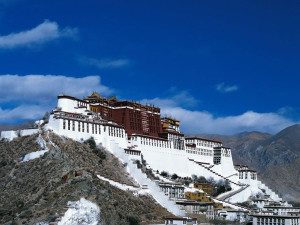
My curiosity about Tibet went way back. As a kid, I was an avid stamp collector, and I remember scouring the globe for this obscure place, Tibet, that didn’t have its own stamps. Every other country had its own.
“Because they’re part of China,” my dad shrugged and went back to mowing the lawn, the air thick with the smell of grass and new spring. As I pulled out weeds with my small fists, I was determined to get to the bottom of it. How strange. Even odder that their leader, the Dalai Lama, with his big thick dark glasses and his kind warming face that reminded me of hot soup on a rainy day, wouldn’t go back to Tibet. He seemed to travel a lot but just never went home.
I learned years later that the Dalai Lama’s life had been threatened, and he had fled his homeland to escape the Chinese occupation. I couldn’t imagine another country invading Canada and our Prime Minister having to escape or be killed.
Then I hit my teenage years and forgot about faraway countries that had no stamps and a homeless leader, and I concentrated on school, boys and why my body was changing so much. It wasn’t until after my university days that a BBC documentary about Tibet awakened my desire to travel there again. As my eyes followed the procession of Tibetan monks trailing the prayer wheels circuit, I thought: I have to go there one day. Everything seemed so peaceful. The way the colorful prayer flags decorated the exterior of temples and mountain passes, like ribbons on presents. The way the saffron robes graced the creaking floors of wooden temples, while the low, soothing sounds of Tibetan trumpets echoed in hallways.
This isolated place, tucked away in the Himalayan Mountains, where McDonalds and Coca Cola hadn’t penetrated, fascinated me. There would be no Starbucks on every corner, no ads constantly flashing in my face, or at least I didn’t think so. I wanted to experience that seclusion, to let my fingers run down the walls of temples where only my footsteps could be heard padding up and down the stairs.
My curiosity for Tibet never left me, but it would be many years before I would travel near that region. Not only was it difficult to get there, but Tibet had been closed to tourists for many years. Instead, shortly after university, I traveled to other places in Southeast Asia, including Vietnam, Malaysia and the Philippines. But now that I was at Tibet’s doorstep, it was time.
And then there was the lure of Mount Everest, its first base camp by the border between Tibet and Nepal. Imagine standing at the foot of the highest mountain on earth! Throughout high school, I had read fascinating stories of those who succeeded and many who perished climbing to the formidable peak, the ground littered over the years with their frozen corpses.
I could go anywhere after that. Thailand, with its beautiful beaches. Burma, with its hundreds of abandoned Buddhist temples dotting the landscape. Cambodia’s Angkor Wat temples.
I wanted to cruise down an unknown street and try a different concoction of food every day, to get lost in a crowd, to be nameless, to relish the transience of meeting others who didn’t care about knowing my past or belonging to my future. I wanted the here and now, the freedom to be engaged in the moment.
This was an excerpt from THE SAME SKY For more excerpts, click here
4 Comments
Comments are closed.

I hope to see Tibet one day – for the temples and mountains. “No Starbucks on every corner” is certainly extra incentive!
Yes Pola one day if you go to Tibet, you will LOVE it there. I’m sure you’ll fall in love with India where you’ll be going soon!
Yes yes yes! I feel the same about Tibet, and even more so about Mongolia. Random, right? I hope to travel to both places one day.
Yes indeed! I’d love to go to Mongolia too one day. And I think you’d love Tibet the “rooftop of the world” with its stunning scenery and extremely kind people despite the hardships they’ve endured.